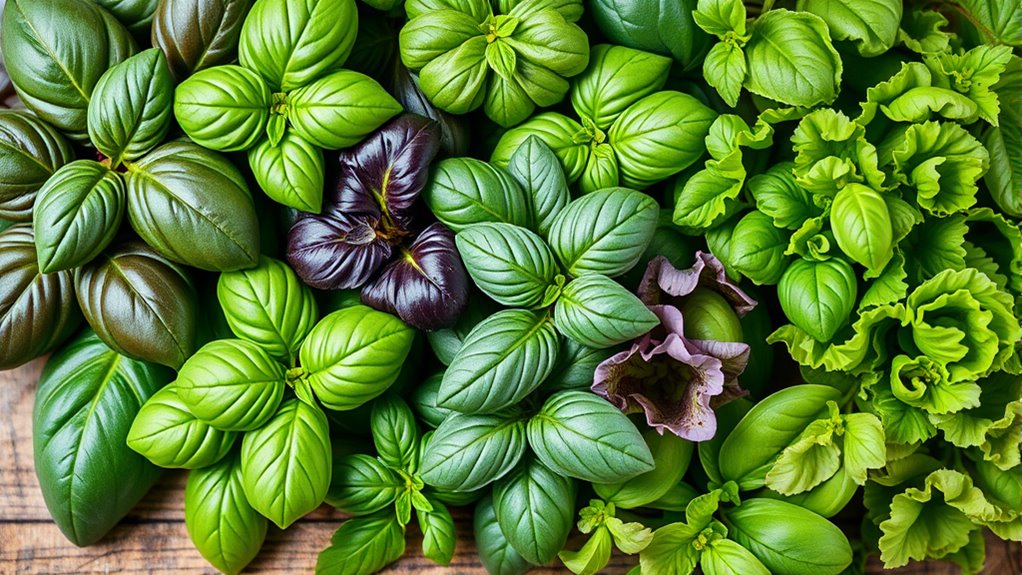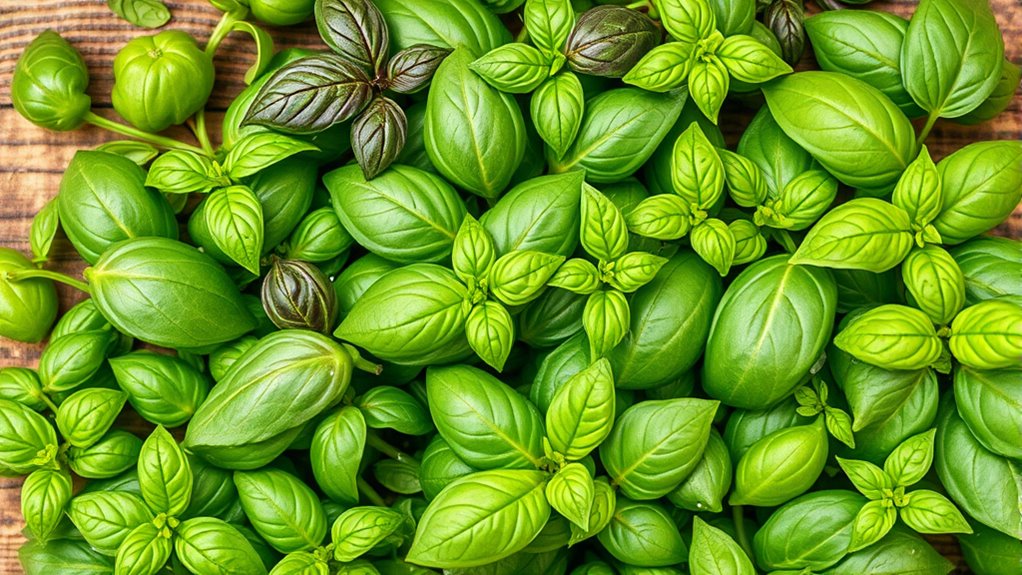In Italian cooking, you mainly use sweet basil and Genovese basil, renowned for their aromatic richness and vibrant flavor. Sweet basil offers a bright, peppery taste with hints of mint, perfect for pesto and salads. Genovese basil has a more intense aroma and larger leaves, making it ideal for traditional sauces. Exploring different basil varieties can elevate your dishes; keep going to discover even more flavorful options for authentic Italian cuisine.
Key Takeaways
- Sweet basil and Genovese basil are the primary varieties used in traditional Italian dishes.
- Genovese basil is favored for its intense aroma and large leaves, ideal for pesto.
- Sweet basil provides a bright, peppery flavor, perfect for caprese salads and pasta.
- Both varieties are harvested fresh to ensure maximum flavor in Italian recipes.
- Basil’s aromatic profiles, especially from these varieties, are essential for authentic Italian cuisine.

Basil is an essential herb in Italian cooking, adding vibrant flavor and aroma to dishes. When you’re growing basil, understanding basil cultivation techniques can make a big difference in the health and quality of your plants. Proper sunlight, well-drained soil, and regular watering are key. You want to plant basil in a spot that gets at least six hours of direct sunlight daily. Use rich, organic soil and ensure good drainage to prevent root rot. Pinching back the tips encourages bushier growth and more leaves, which means more fresh basil for your recipes. Regular harvesting not only provides you with flavorful leaves but also keeps the plant vigorous and productive. When you’re cultivating basil, keep an eye out for pests like aphids and fungal issues, and address them early with natural remedies. Additionally, choosing the right basil varieties with flavor profiles that suit your dishes can enhance your culinary experience.
Basil flavor profiles vary among different varieties, and knowing these differences can elevate your cooking. For example, sweet basil, the most common in Italian cuisine, offers a bright, slightly peppery taste with hints of mint and clove. It’s perfect for traditional pesto, caprese salads, and pasta dishes. Genovese basil, a variety of sweet basil, has more intense aroma and a slightly larger leaf, making it a favorite for authentic pesto. Thai basil, with its anise-like flavor, introduces a more complex profile, often used in fusion dishes or to add depth to tomato sauces. Lemon basil provides a citrusy twist that brightens up salads and seafood dishes, while purple basil adds a visual pop and a slightly spicier, more pungent flavor. Each variety’s unique basil flavor profiles allow you to experiment and tailor dishes to suit different tastes and culinary traditions.
When selecting basil varieties, think about how their flavor profiles will complement your dishes. Fresh basil leaves should be harvested often, ideally in the morning when their essential oils are most potent. Incorporate different basil types to create layered flavors in your cooking, from the sweet aroma of classic Italian basil to the more exotic notes of Thai or lemon basil. Understanding basil cultivation techniques ensures your plants thrive, giving you a steady supply of fragrant leaves. By paying attention to the specific basil flavor profiles, you can choose the right variety for each recipe, enhancing your dishes with fresh, authentic flavor. Whether you prefer the familiar sweetness of Italian basil or the aromatic punch of other varieties, cultivating and using the right basil can truly transform your culinary creations.
Frequently Asked Questions
Which Basil Variety Has the Strongest Aroma?
When choosing basil, you might wonder which variety has the strongest aroma. You’ll notice that aroma intensity varies, with some types offering a more potent fragrance strength. Typically, African blue basil and Thai basil stand out for their robust scent, making them ideal if you want a bold aroma. If fragrance strength is your priority, try these varieties—they deliver a more intense and lingering aroma that enhances your dishes beautifully.
Can I Substitute One Basil Variety for Another?
You can substitute one basil variety for another, but be aware of basil flavor differences that may affect your dish. Some varieties, like sweet basil, have a milder, sweeter taste, while others, like Thai basil, offer a more pungent, spicy flavor. Use basil substitution tips by adjusting quantities and tasting as you go. Keep in mind that the aroma and flavor profile might change, so choose your substitute accordingly for the best results.
How Do Basil Varieties Differ in Flavor Profile?
You wonder how basil varieties differ in flavor profile. Each variety offers distinct flavor intensity differences; for example, sweet basil has a mild, aromatic taste, while Thai basil features a spicier, more anise-like flavor. To enhance your dishes, try herb combination tips like pairing lemon basil with seafood or purple basil with salads. Experimenting with these varieties lets you tailor your culinary creations, adding depth and unique notes to your recipes.
Are There Basil Types Suitable for Pesto?
If you’re making pesto, choose basil varieties like Genovese or sweet basil, as they have a robust flavor ideal for blending. These types are also easier to grow, so basil pest control and basil harvesting tips become essential to keep your plants healthy. Proper harvesting ensures fresh leaves with vibrant flavor, while pest control prevents damage. Using the right basil variety guarantees a flavorful, aromatic pesto every time.
Which Basil Varieties Thrive in Outdoor Italian Gardens?
Imagine your garden as Italy’s lively piazza, where basil is the star. To thrive outdoors, you’ll want sweet basil and Genovese basil, symbols of classic Italian flavors. These varieties flourish with full sun, well-drained soil, and regular watering. For culinary uses, they add vibrant aroma and flavor to dishes. Follow basil cultivation tips like pruning and mulching, ensuring your plants stay healthy, so you can harvest fresh basil for authentic Italian recipes.
Conclusion
Just as a master painter chooses the perfect colors for their canvas, selecting the right basil variety elevates your Italian dishes. Each leaf adds its unique hue, transforming a simple meal into a vibrant masterpiece. Embrace the variety, and your cooking becomes a flavorful gallery. Remember, the key to authentic Italian flavor isn’t just the recipe, but the palette of basil you choose to bring it to life.









